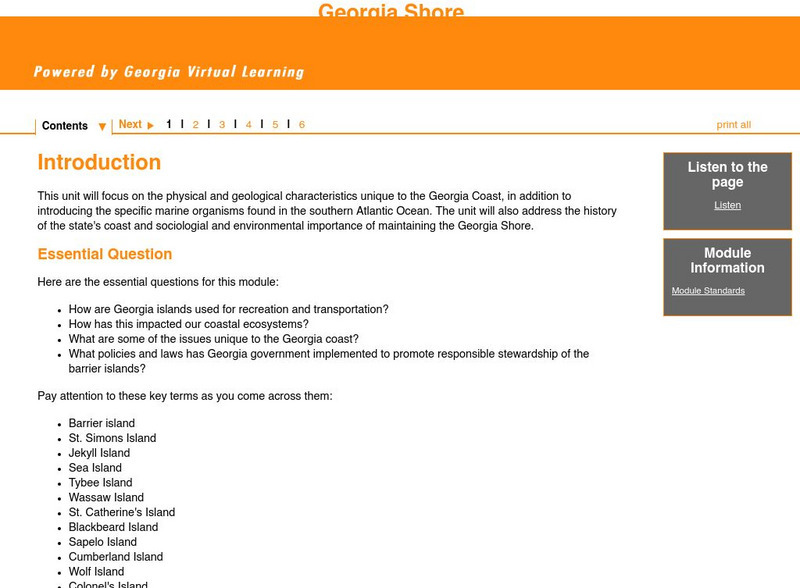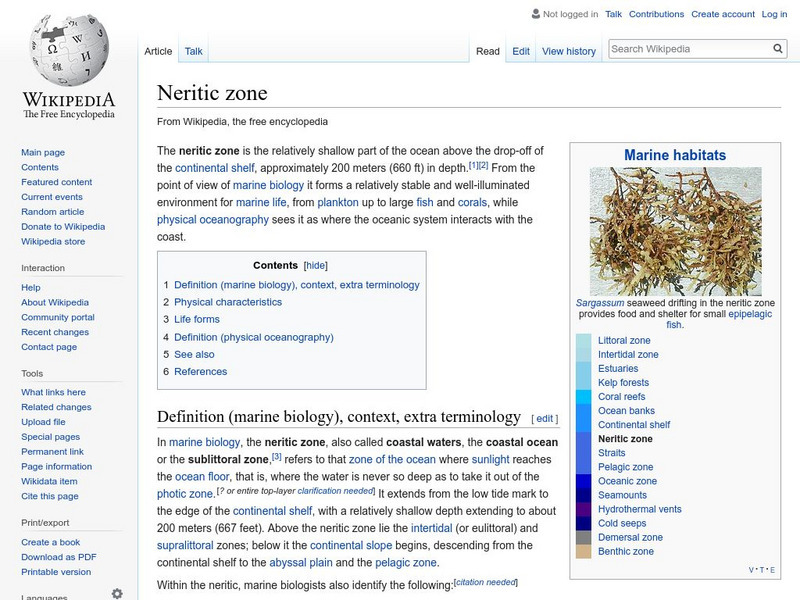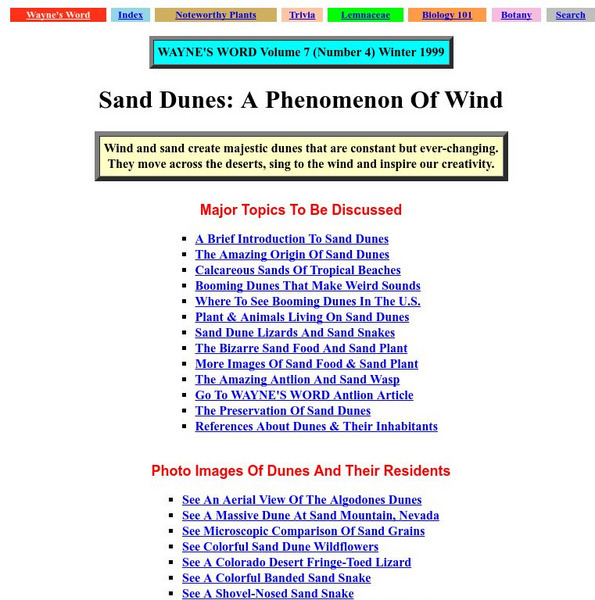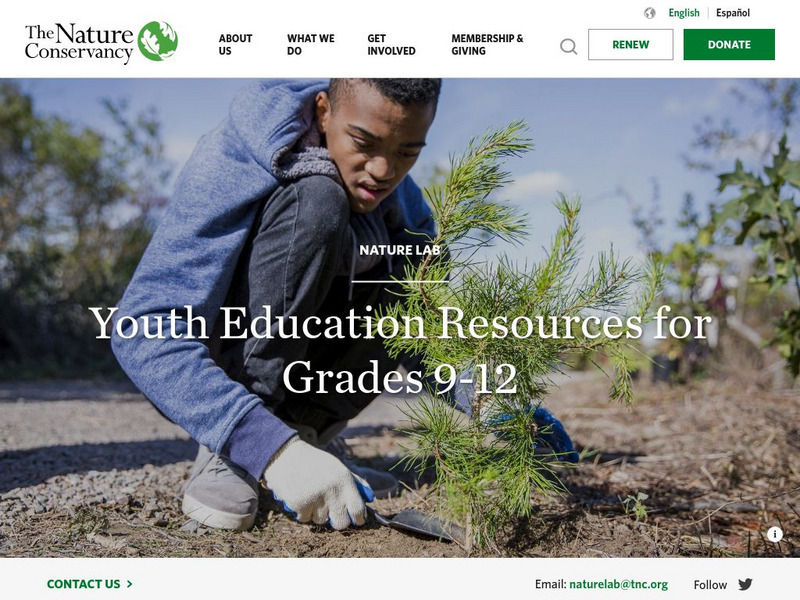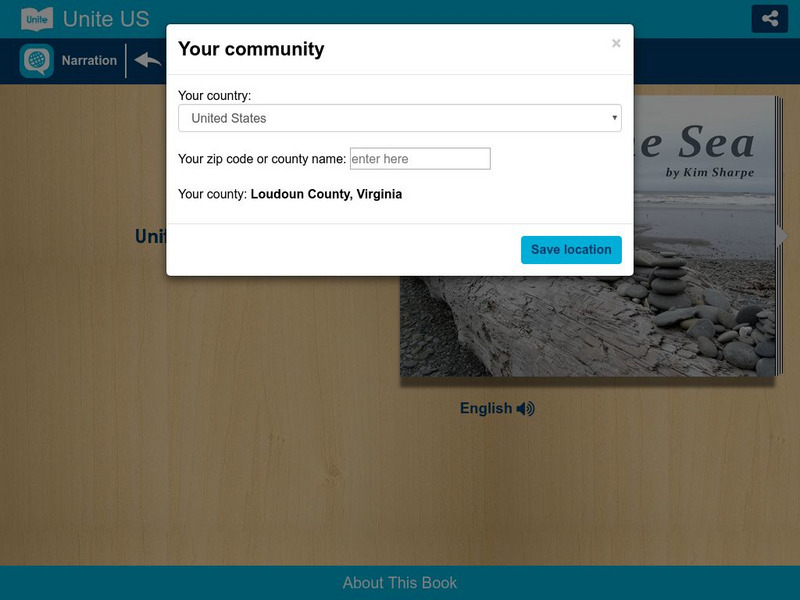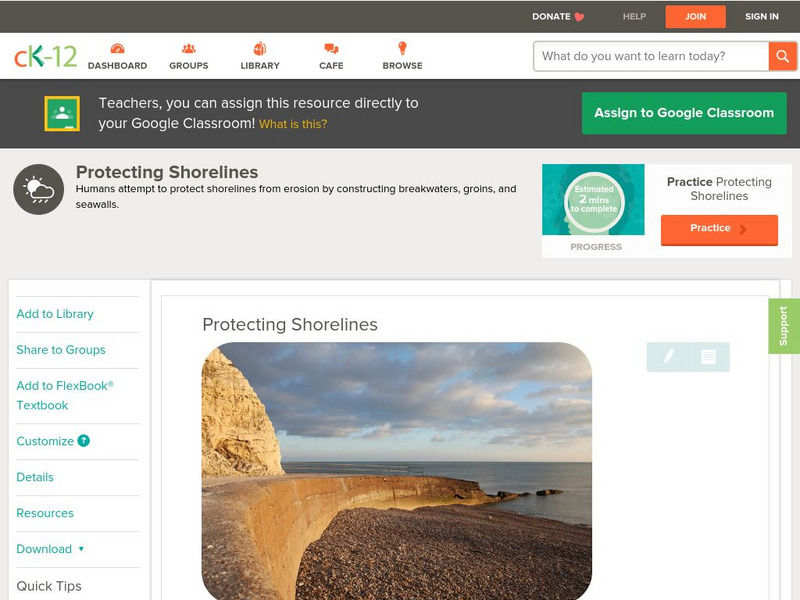Curated OER
Sand Shakes & Mud Pies: Investigating Sediment
Take a field trip to a location where water and land meet to study patterns of sediment organization in wet habitats: river or ocean beaches, sand dunes, tidal marshes, the edge of a pond, or a woodland stream. Small groups collect pairs...
Curated OER
Earth Science
Young scholars analyze the mechanisms for generating ocean currents, temperature, and deep ocean circulation. They are able to assess the formation and breaking of waves and their effect on shorelines, particularly the North Carolina...
Curated OER
Get Out in the Field
Students visit a shoreline--of an ocean, a lake, a pond, a riverbank, etc., survey it and record what they find there. They map the shoreline and surrounding area and conclude where potential waterfront projects could occur.
Georgia Department of Education
Ga Virtual Learning: Coastal Ecosystems
Students are introduced to the various marine environments, their unique formations, origin and identifying characteristics.
Georgia Department of Education
Ga Virtual Learning: Georgia Shore
Find out about the physical and geological characteristics unique to the Georgia Coast, in addition to the specific marine organisms found in the southern Atlantic Ocean. Also learn the history of the state's coast and sociological and...
PBS
Pbs Learning Media: Sandy Coasts
In this interactive resource adapted from the National Park Service, learn about beaches, spits, and other sandy landforms that characterize some of America's coastal national parks.
Encyclopedia of Earth
Encyclopedia of Earth: Ocean Oil: Coastal Ecosystems
A collection of articles, video, and some teaching guides on issues related to coastal ecosystems. Includes environmental issues, e.g., oil spills, and different types of ecosystems, e.g., mangroves and coastal grasslands.
Wikimedia
Wikipedia: Neritic Zone
Learn about the neritic zone, also called the sublittoral zone or sea floor.
Palomar Community College District
Wayne's Word: Sand Dunes: A Phenomenon of Wind
An engaging natural history of sand dunes. From beaches to deserts you will learn about the formation and ecology of these ecosystems.
Nature Conservancy
Nature Works Everywhere: Where's the Beach? Protecting Coastlines From Erosion
Recognize resourceful and budget-friendly methods to help restore and protect coastlines. View the video and utilize the lesson plans.
Unite for Literacy
Unite for Literacy: Earth and Sky: By the Sea
Read about the different sights you can see along the seashore. Includes audio narration in English and Turkish with text in English.
PBS
Pbs Learning Media: Coastal Geological Processes
This interactive resource adapted from the National Park Service describes the many forces that affect shorelines, including tides, weathering, erosion, and deposition. Includes background reading handout and discussion questions.
PBS
Pbs Learning Media: Coastal Geological Materials
This interactive resource adapted from the National Park Service describes the different kinds of sediments that make up coastlines, with a focus on the variety in color, size, and sorting.
American Museum of Natural History
American Museum of Natural History: O Logy: A Sea of Questions About Mangroves
An engaging piece featuring questions that scientists ask when they are researching the seas. Click on the red asterisks and discover even more information!
Missouri Botanical Garden
Missouri Botanical Garden: Temperate Oceans
This site from the Missouri Botanical Garden is a comprehensive site covering various topics related to temperate oceans. Be sure to check out the ocean animals link on the left side to learn more about the invertebrates that live in the...
American Institute of Biological Sciences
Action Bioscience: Beach Closings: Science Versus Public Perception
The media is relaying inaccurate information as to why an increasing number of beaches are being closed. Understand the scientific reasoning for the closures versus the political and economic motivated reasons.
PBS
Pbs: Sandy Coasts
In this interactive resource adapted from the National Park Service, learn about beaches, spits, and other sandy landforms that characterize some of America's coastal national parks.
John Wiley & Sons
Wiley: Physical Geography: Animation: Wave Refraction
A brief animation that demonstrates the impact of waves on headlands and on bays explaining how waves shape sea arches and beaches.
CK-12 Foundation
Ck 12: Earth Science: Protecting Shorelines
[Free Registration/Login may be required to access all resource tools.] Describes the barriers that humans construct to protect beaches and shorelines.
Cornell Lab of Ornithology
Habitat Network: Ecological, Practical, Aesthetic Advantages of Wild Shorelines
Habitat Network examines what we know about the ecological functioning of shorelines, and makes recommendations for design, planting, and management of these specialized zones.
American Museum of Natural History
American Museum of Natural History: Mangroves O Logy Card
Flip over this interactive OLogy card to learn about mangrove forests and their importance to coastal ecosystems.
Cornell Lab of Ornithology
Habitat Network: Coastal
Learn about coastal habitats, and how to help support nesting shorebirds.
Nature Conservancy
Nature Conservancy: Planet Earth: Oceans and Coasts
Compilation of the Nature Conservancy's content about the ecology of oceans and coasts. Emphasis is on the biodiversity of these habitats and the human impact on the animal and plant life that live in our oceans and on our coasts.
University of Maryland
Coastal & Marine Environments: Transgressions & Regressions
These are lecture notes for a course in historical geology. They look at different types of coastlines where marine and terrestrial environments interact and the geological characteristics of each, followed by a discussion of...






